#macrolichen
Explore tagged Tumblr posts
Note
Did you see that paper about the Bryoria fremontii/tortuosa lichens? How they're genetically identical, but the researchers found basidiomycetes yeast embedded in the cortex of the tortuosa samples? I'm never not thinking about it.
If you mean "Basidiomycete yeasts in the cortex of ascomycete macrolichens" then yes indeed. We assign it for our class, and so my lab group has picked it apart a bunch of times over. I think the research is cool, but I think they are taking too big a swing with the whole idea that we need to reconceptualize the lichen symbiosis. They found a cool phenomenon in one lichen species, and they brought attention to the importance of considering comensalistic and symbiotic associations of microorganisms, but it's too much to assume this is going on all the time (and no one else has been able to find similar patterns so . . . )
24 notes
·
View notes
Text
oh and my dad got me the new macrolichens in Ontario book from the library which is super pog and the photos are fantastic!! so i am hoping to do more lichen-related things as well
#original#i already made a zine about local lichens#i made a page on my website about local lichens#i want to move forward with lichen art projects like my linocut and embroideries and drawings#the book isn’t suitable for me to scan it or i would! hopefully it’ll be on libgen or something soon
0 notes
Photo


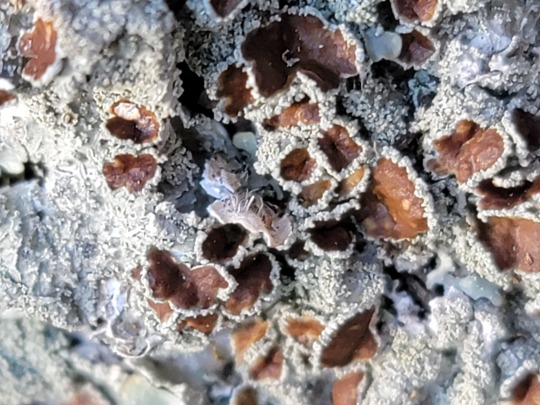



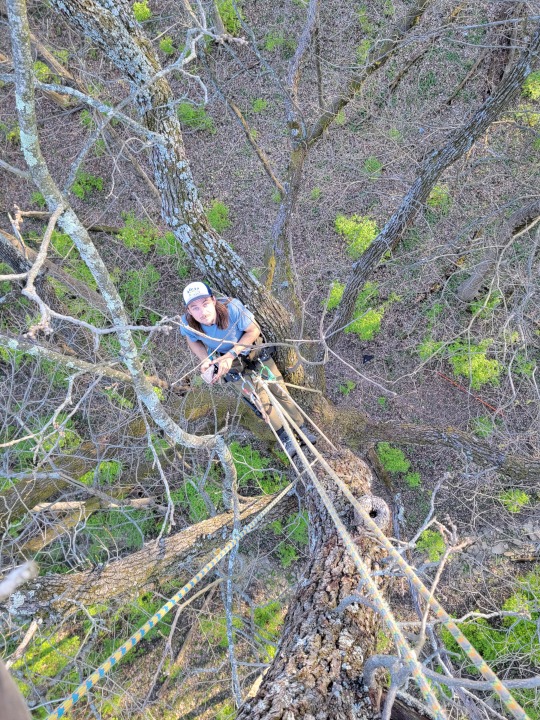


two dope ass macrolichens I got very excited about in a walnut tree last spring (55 dbh walnut 115 feet top to bottom which is the biggest black walnut i’ve ever climbed hidden in this valley in Mt. Airy forest in Cincinnati. )
I was excited because I don’t see these in Cincinnati though they are common in southern Ohio despite the fact. Really uncommon in city regions due to heat island issues low rainfall compared to past rain due to deforestation and climate change, and the classic air pollution problem. We got lucky, this walnut was in a valley and surrounded by forest, the tips were caked in one of these though the other was just pure luck to begin with. My first time seeing this species out of high quality habitat like Adams county Ohio or RRG region Kentucky.
Top is my favorite lichen, a somewhat variable species that appears on moss thats on dolomite, or moss thats on trees.
Shaggy-fringe Lichen, like even the apothecia are fringed!, when hydrated the thallus is an emerald green, its puffy sometimes and looks like a fringy tube lichen and sometimes the thallus looks thin like this picture, Anaptychia palmulata
Moondust Speckled Lichen with its dope apothecia large and in charge, Punctelia caseana
#anaptychia#anaptychia palmulata#punctelia#punctelia caseana#lichen#mycology#botany#plantblr#macrolichens#macrolichen#ohio#danny#arborculture
18 notes
·
View notes
Photo

Day 20 #stradaeasel challenge I've always admired nicely painted backlit scenes, but haven't made that many myself - today I thought it was time I changed that! Here's a glowing mink skull to bring you warmth and good tidings! #painting #art #stilllife #skull #vultureculture #oilpainting ##raymarpanel #backlit #dailypainting #allaprima #artcollector #artforsale #pacificnorthwest #macrolichen #instaart #stradaeaselchallenge2021 @strada.easel https://www.instagram.com/p/CKTEyJ9DnYs/?igshid=5jbkwx3b1bcz
#stradaeasel#painting#art#stilllife#skull#vultureculture#oilpainting#raymarpanel#backlit#dailypainting#allaprima#artcollector#artforsale#pacificnorthwest#macrolichen#instaart#stradaeaselchallenge2021
12 notes
·
View notes
Photo




lichen on a tree
Catskill Mts NY
10 notes
·
View notes
Photo

'Watch out! It's very, very fragile! This is a leafy "macrolichen", a sort of moss that is a symbiose between an algea and a fungi. Beautiful right?' . #pacoandfrancisco #piecesofnature #macrolichen #nature #moss #design #woodworking #tinyworlds #shousugiban #pacokamil
#piecesofnature#macrolichen#nature#moss#woodworking#design#tinyworlds#pacoandfrancisco#shousugiban#pacokamil
1 note
·
View note
Text
Líquenes: casa de muchos
No es uno ¡son dos! ¿tal vez tres? ¿más?

Los líquenes son en esencia organismos compuestos, creaturas simbióticas. Tradicionalmente, se les definía como integrados por un micobionte (un hongo) y un fotobionte (algún organismo que haga fotosíntesis: como las algas verdes o cianobacterias). Sin embargo, estudios realizados durante la última década han cambiado la forma en que vemos los líquenes, y dejado en claro que se tratan de algo más complejo. Un pequeño y auto-contenido ecosistema.
Por ejemplo, en un estudio realizado en 2016, identificaron la presencia extendida de levaduras (otro hongo! pero unicelular) en un par de líquenes de Norteamérica. Estas levaduras, en el caso de las dos especies de liquen (Bryoria spp.) fueron la diferencia clave, que explicaba la hasta entonces inexplicada coloración distinta entre ambas especies. Es decir, un tercer, y hasta entonces anónimo integrante, estaba afectando directamente las características físicas del liquen.
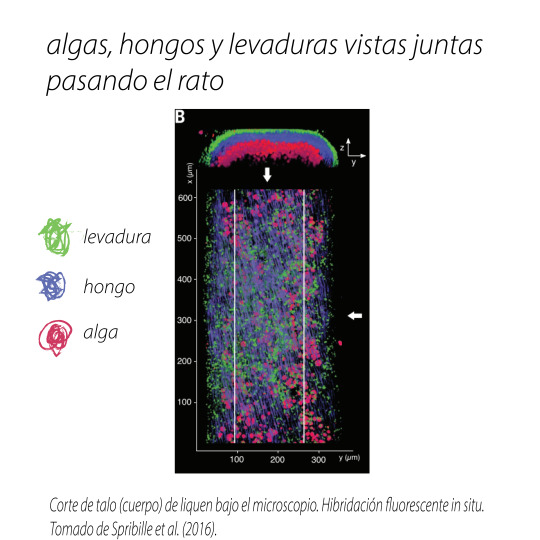
Ese es solo un ejemplo. Además de levaduras, hay muchos otros microorganismos asociados a los líquenes: se han encontrado bacterias, protistas e incluso virus en ellos. ¿Qué tanto son parte de esta simbiosis?
Algunas bacterias sirven en este pequeño ecosistema como fijadoras de nitrógeno, ciertas bacterias se encuentran solo en la superficie o aprovechan la humedad y sombra debajo del talo. La estructura, forma y función de los líquenes podría estar dictada por estos discretos participantes ¡pero aún no lo sabemos!
A continuación algunos líquenes vistos en Oaxaca:


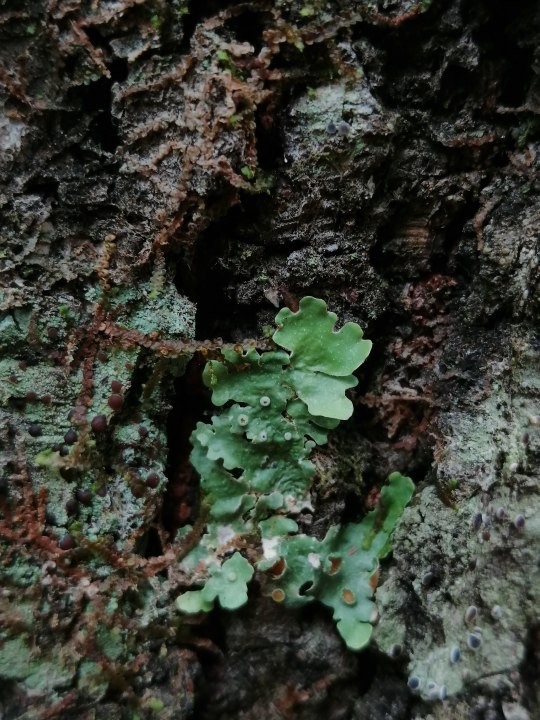
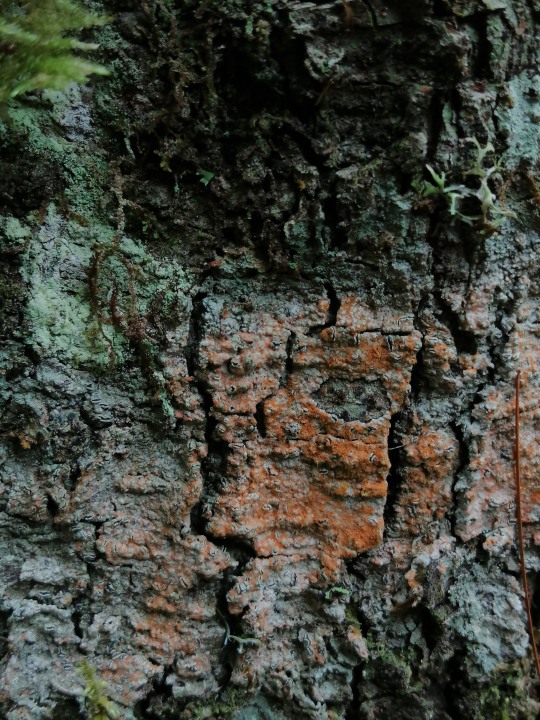

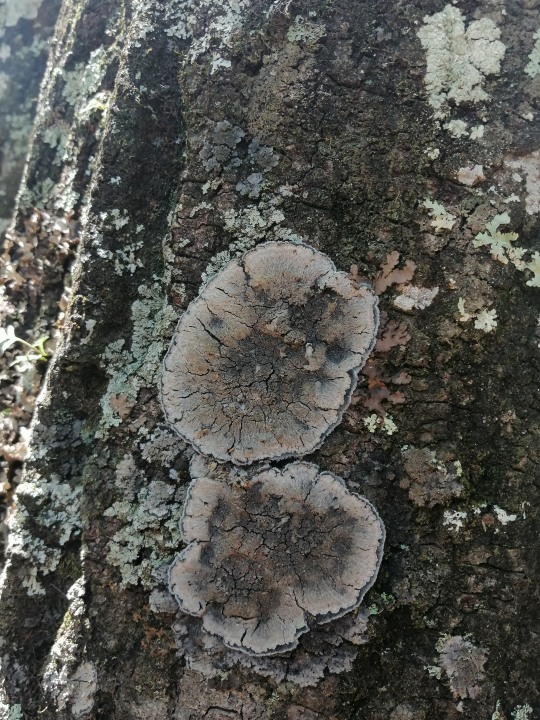
Literatura consultada
Spribille, T., Tuovinen, V., Resl, P., Vanderpool, D., Wolinski, H., Aime, M. C., ... & McCutcheon, J. P. (2016). Basidiomycete yeasts in the cortex of ascomycete macrolichens. Science, 353(6298), 488-492.
Morillas, L.; Roales, J.; Cruz, C.; Munzi, S. Lichen as Multipartner Symbiotic Relationships. Encyclopedia 2022, 2, 1421–1431. https://doi.org/ 10.3390/encyclopedia2030096
Nash, T. H. (Ed.). (2008). Lichen biology. Cambridge University Press
2 notes
·
View notes
Text
More on how the inland temperate rainforest region of the interior Pacific Northwest hosts one of the single most biodiverse epiphytic lichen communities in the world, with higher arboreal lichen biodiversity than the coastal temperate rainforest.



An old-growth cedar stand typical of inland temperate rainforest, at BC��s Ancient Forest / Chun t’oh Whudujut Provincial Park. [Photos from Ancient Forest Alliance.]

“Smoker’s lung lichen” (Lobaria reigera) is a rare arboreal lichen that is mostly limited to the temperate rainforests of the Great Bear Rainforest and Pacific coastline, but some isolated populations are also found in the inland temperate rainforest region. [Photo by P. Bartemucci.]
Since 2002, the Valhalla Wilderness Society has sponsored research on inland rainforest lichens by lichenologist Toby Spribille, formerly based at the University of Gottingen, Germany. Spribille has worked closely with BC lichenologists Curtis Bjork and Trevor Goward. They have found that the inland temperate rainforests contain one of the richest tree lichen floras in the world -- richer than BC’s coastal temperate rainforest. Spribille, Bjork, and Goward found more species of lichens in the Incomappleux Valley than tree, shrub, herb, grass and moss species combined. [Source: Valhalla Wilderness Society, 2008.]
Temperate rainforest ecosystems have been widely recognized as a major repository for biodiversity, particularly for organisms that live within forest canopies. In western North America, coastal temperate rainforest ecosystems have been the focus of increased attention in recent years. [...] However, in British Columbia (B.C.) a second major temperate rainforest ecosystem is found on the windward slopes of interior mountain ranges. This inland temperate rainforest (ITR) has many unique characteristics, including globally significant assemblages of canopy lichens and mosses. Some 40% of oceanic epiphytic macrolichens found in Pacific coastal rain forests also occur in these inland rainforests. Among oceanic epiphytic species found in the inland rainforest are the hanging moss (Antitrichia curtipendula) and lichen genera such as Chaenotheca, Chaenothecopsis, Collema, Fuscopannaria, Lichinodium, Lobaria, Nephroma, Parmeliella, Polychidium, Sphaerophorus, and Sticta conclude that “conifer forests of intermontane British Columbia support at least 31 cyanolichen species -- one of the richest epiphytic cyanolichen assemblages in the world”. They suggest that maximum cyanolichen diversity is associated with the co-occurrence of nutrient-rich sites in lowland old-growth inland rainforest sites. [Source: ��Predicting canopy macrolichen diversity and abundance within old-growth inland temperate rainforest.” Forest Ecology and Management, 2009.]
We report our initial findings of 39 lichen taxa, including several rare species and cyanolichens, which may be especially sensitive to climate. […] Some of the world’s most famous temperate rainforests occur along the west coast of North America. A lesser known, but equally unique ecosystem is the inland temperate rainforest (ITR), which is predominantly located in British Columbia between 50° and 54°N. The ITR shares many characteristics with its coastal counterparts, including large diameter western redcedar (Thuja plicata), some speculated to be over 1000 years old (Radies et al. 2009), and a dense understorey of devil’s club (Oplopanax horridus). This ecosystem provides important habitat for many species, including the threatened mountain ecotype of woodland caribou, and many disjunct populations of characteristically coastal lichen species. Old-growth coniferous stands in the ITR support exceptionally rich epiphytic lichen communities, especially cyanolichens lichens that have a cyanobacterial photobiont as one of their symbiotic partners. [Source: “A Framework for Climate Monitoring with Lichens in British Columbia’s Inland Temperate Rainforest.” Journal of Ecosystems and Management.]


Biatora aureolepra, an arboreal lichen species formally described in 2009, from the inland temperate rainforest. Photo from: “Contributions to an epiphytic lichen flora of northwest North America: Eight new species from British Columbia inland rain forests” (2009).

Coral lichen (Sphaerophorus venerabilis), an arboreal lichen from the inland temperate rainforest that requires the presence of old-growth cedar-hemlock stands. [Photo by David Moskowitz.]
818 notes
·
View notes
Photo


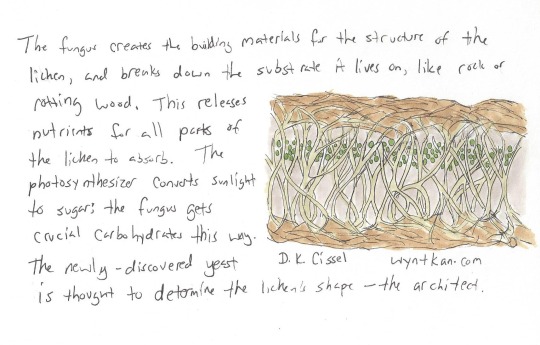
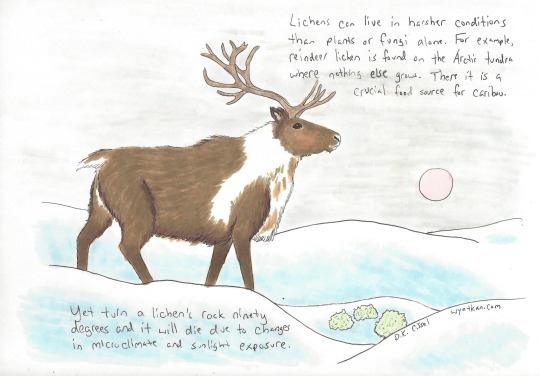
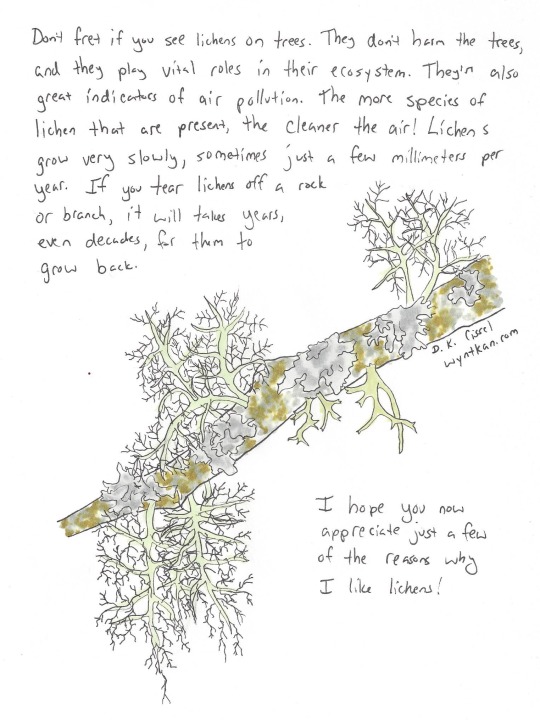
Lichens are incredible beings, as far as I'm concerned, and some of the most misunderstood and overlooked as well. I appreciate their complexity and tenacity, and I also think they're pretty, too! I'm very lucky that there's a lot of lichen diversity where I live; I am in a place with several microbiomes, and so it's neat seeing which species I find in each. Plus it's a good sign that the air here is clean, too.
I do have to say that as a citizen-level naturalist rather than a lichenologist, I sometimes feel a bit overwhelmed by how some lichens are so similar that you basically need a microscope to tell two species apart. I once went out into the woods with my copy of Macrolichens of the Pacific Northwest, intent on identifying all the lichens I found, and while I was able to nail down some, there were others that I just wasn't able to get a species-level ID on. (And then I uploaded pictures to iNaturalist and let the experts tell me what I was missing!)
Admittedly, if I had infinite amounts of time and money and could go back to school (again), I'd strongly consider mycology with an emphasis on lichenology. But then again I'm also tempted by the bryophyte end of the botany pool. And marine biology is pretty neat, too. Also restoration ecology...you know, maybe it's better that I just opted to be a Master Naturalist. I don't have to choose a specialty, and it didn't cost nearly as much!
Species portrayed: Questionable rock-frog (Xanthoparmelia cumberlandia), old man's beard (Usnea spp.), red alder (Alnus rubra), pixie cup lichen (Cladonia asahinae), reindeer moss (Cladonia rangiferina), caribou (Rangifer tarandus), hammered shield lichen (Parmelia sulcata), oakmoss (Evernia prunastri), assorted microlichens
159 notes
·
View notes
Note
Why do academic books gotta be so pricey I'm dying over here. 80 gotdamn dollars for a regional macrolichen guide, and 169 for a book about lichen substrates and that's secondhand :'0
Capitalism.
But really I don't understand the price tags on all scientific and academic publishing. The prices are so ridiculously inflated and I don't know who benefits, but I know that it inconveniences most people--scientists, students, and anyone interested in this stuff.
31 notes
·
View notes
Photo
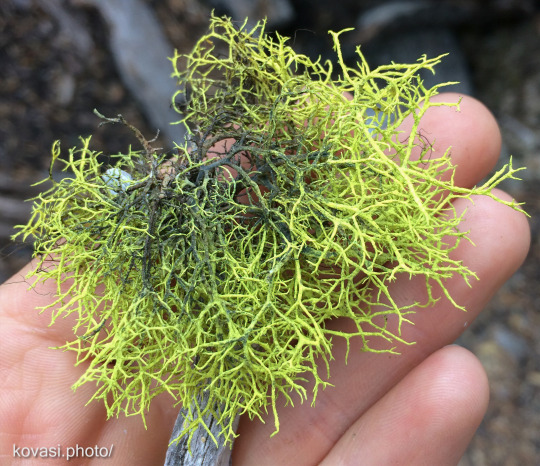
Bajpai, Rajesh, Vertika Shukla, D. Upreti, and K. Semwal. "Selection of Suitable Lichen Bioindicator Species for Monitoring Climatic Variability in the Himalaya." Environmental Science and Pollution Research 21.19 (2014): 11380-1394. Web.
This study taking place in the Govind Wildlife Sanctuary in the Himalayan mountains of India looked at three different epiphytic macrolichens and compared their potential as indicator species for certain kinds of air pollution using environmental variables and comparison to a GIS created map of pollution profiles. Samples were analyzed for metals and polycyclic aromatic hydrocarbons (PAH). They mapped the different elemental concentrations of the three species separately using geostatistical analysis techniques. Rasters were created for causational air quality factors using interpolated distance weighting (IDW) that were then normally co-krigged, all in ArcGIS. The different lichen species accumulated metals and PAHs significantly differently and that long-range transport of pollutants is affecting the remote Himalayan mountains at high elevations. The IDW map helped show the spatial distribution of contaminants based on the lichen data for areas where no data had been collected. This is applicable to my research because my study area has quite a bit of high elevation land in it, and learning more about pollution transport and lichens in these kinds of systems is very useful. I would love to be able to make maps like these for my elemental analysis data.
1 note
·
View note
Photo
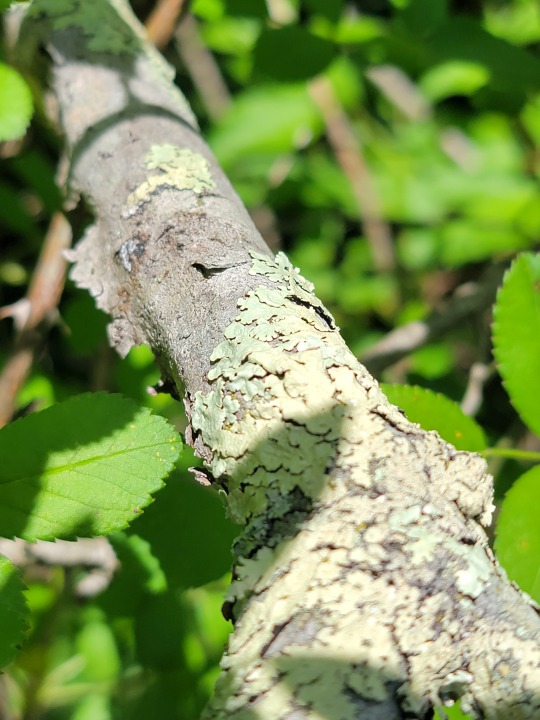


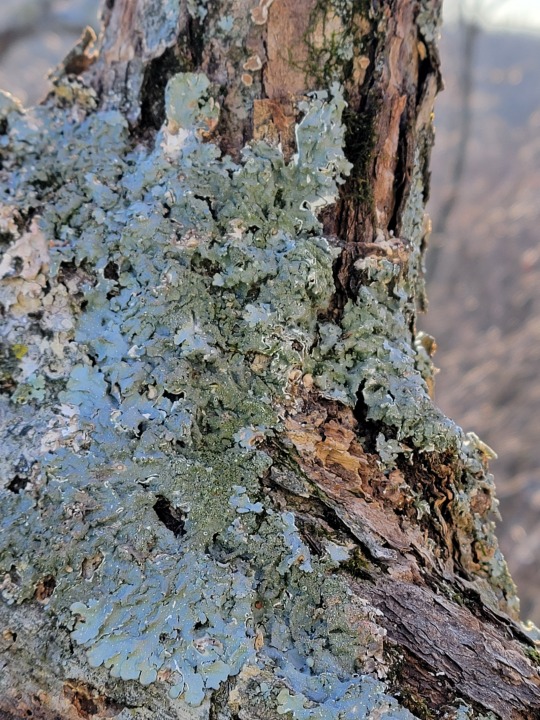




Some super common macro lichens in the midwest you can readily learn. Generalized to mainly wood surface and not super generalized on rock.
Common Greenshield Lichen, Flavoparmelia caperata
vs
Punctelia rudecta, and recent split Punctelia missouriensis (see those white speckled lobes. during full developement and we see a different colored isidiate core. this is why it’s commonly known as the rough speckled shield ) (this concept can be seen in the lower specimen.) (The upper though developes consistently less isidiate core and instead has overlapping squamulobes which gives it a mealy look.) (Called Mealy Speckled Shield lichen.)
What isn’t as common is large thallus mats with proper apothecia developement. Its like a light blue core if it’s the case unlike moon glow lichen which has a brown apothecia core and smooth axle bristle which looks green when hydrated and has an orange like tint when dry. imishaga doesn’t seem to produce apothecia or an isidiate core while rough speckled can produce both though the apothecia are supposed to be small like seen above on this Quercus muehlenbergii
the green shield will be smooth, baltimore green shield is a rock species where as smooth(rare) and common are both on wood, not an isidiate display, and fully same colored thallus wet or dry.
the bottom picture is the two colored thallus of rough speckled sheild without an isidiate core that i put water on to see if i could get hydrated colors.
#shield macro lichen#punctelia rudecta#punctelia#flavoparmelia#flavoparmelia caperata#lichen#ohio#botany#mycology#punctelia missouriensis#macrolichens#macrolichen#arborculture
17 notes
·
View notes
Photo

#stradaeasel Day 1 "Lots of Lichen" 8" x 10" oil on linen, 2020 I'm starting the new year off right painting Oregonian macro lichen on a #raymarart linen panel; great stuff! I hope 2021 is a productive and creative year for everyone! #stradaeaselchallenge #still life #originalart #pacificnorthwest #oilpainting #natureart #macrolichen #ceramic #artistsofinstagram https://www.instagram.com/p/CJiG3LED1U4/?igshid=dxj1k9qb1coa
#stradaeasel#raymarart#stradaeaselchallenge#still#originalart#pacificnorthwest#oilpainting#natureart#macrolichen#ceramic#artistsofinstagram
8 notes
·
View notes
Photo

#bloomingmoss #lichen #macrolichen #foliose #folioselichen #pacificcoasttrail #palmsprings #granite #moss #green #superbloom (at Palm Springs, California)
#foliose#palmsprings#granite#pacificcoasttrail#macrolichen#superbloom#green#folioselichen#lichen#moss#bloomingmoss
0 notes
Photo

Foliose #lichen #macrolichen #tree #winterwalk #wagnernaturalarea #parklandcounty #sprucegrove #alberta #canada #jacksoncrabb #saturday (at Spruce Grove, Alberta)
#canada#macrolichen#wagnernaturalarea#sprucegrove#parklandcounty#tree#lichen#winterwalk#jacksoncrabb#alberta#saturday
0 notes
Text
some weird niche plant publications i want to get once i get enough money to splurge on things again:
published and sold by the American Bryological and Lichenological society:
set of both “Supplement to “Chemical and Botanical Guide to Lichen Products” (1976) and “Second Supplement to “Chemical and Botanical Guide to Lichen Products” (1977) - $18
“Lichenographia Thomsoniana: North American Lichenology in Honor of John W. Thomson“ (1998) - $20
“Lichens of Long Island, New York: A Vegetational and Floristic Analysis” (1968) - $9
published and sold by the Hardy Fern Foundation:
“20th Anniversary ‘How To’ Special Issue” - $12
“Fern Propagation Handbook” - $10
other things:
a copy of the famous “Insectivorous Plants” by Charles Darwin
“Macrolichens of the Pacific Northwest“ (might get this sooner rather then later for my project)
a print copy of Thomas Nash’s “Lichen Biology” IF i can find one for dirt cheap
“Lichen Physiology and Cell Biology” by D. H. Brown again IF i can find one for dirt cheap but thats like. right up my alley man
a membership to the British Lichen Society’s journal The Lichenologist, preferably with the print copy option bc hhhhhhghghghhhh book look good on shelf
#i kno i kno i literally JUST got a Nice Cool Comprehensive Plant Book that used up most of my book budget#but i .......leik they........#books
291 notes
·
View notes